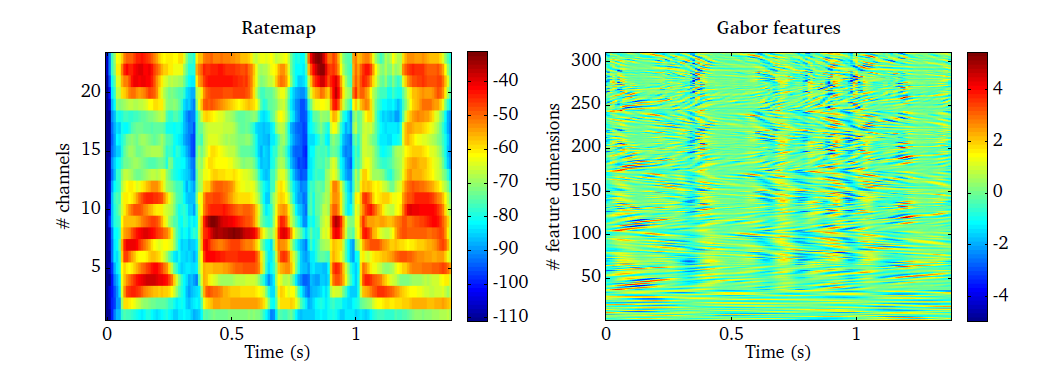Spectro-temporal modulation spectrogram¶
Neuro-physiological studies suggest that the response of neurons in the primary auditory cortex of mammals are tuned to specific spectro-temporal patterns [Theunissen2001], [Qiu2003]. This response characteristic of neurons can be described by the so-called STRF. As suggested by [Qiu2003], the STRF can be effectively modelled by two-dimensional (2D) Gabor functions. Based on these findings, a spectro-temporal filter bank consisting of 41 Gabor filters has been designed by [Schaedler2012]. This filter bank has been optimised for the task of ASR, and the respective real parts of the 41 Gabor filters is shown in Fig. 36.
The input is a log-compressed rate-map with a required resolution of 100 Hz, which corresponds to a step size of 10 ms. To reduce the correlation between individual Gabor features and to limit the dimensions of the resulting Gabor feature space, a selection of representative rate-map frequency channels will be automatically performed for each Gabor filter [Schaedler2012]. For instance, the reference implementation based on 23 frequency channels produces a 311 dimensional Gabor feature space.
The Gabor feature processor is demonstrated by the script
DEMO_GaborFeatures.m, which produces the two plots shown in
Fig. 37. A log-compressed rate-map with 25 ms time frames and 23
frequency channels spaced between 124 and 3657 Hz is shown in the left panel for
a speech signal. These rate-map parameters have been adjusted to meet the
specifications as recommended in the ETSI standard [ETSIES]. The
corresponding Gabor feature space with 311 dimension is presented in the right
panel, where vowel transition (e.g. at time frames around 0.2 s) are well
captured. This aspect might be particularly relevant for the task of ASR.

Fig. 37 Rate-map representation of a speech signal (left panel) and the corresponding output of the Gabor feature processor (right panel).
| [ETSIES] | ETSI ES 201 108 v1.1.3 (2003), “Speech processing, transmission and quality aspects (STQ); distributed speech recognition; front-end feature extraction algorithm; compression algorithms,” http://www.etsi.org. |
| [Qiu2003] | (1, 2) Qiu, A., Schreiner, C. E., and Escabì, M. A. (2003), “Gabor analysis of auditory midbrain receptive fields: Spectro-temporal and binaural composition.” Journal of Neurophysiology 90(1), pp. 456–476. |
| [Schaedler2012] | (1, 2) Schädler, M. R., Meyer, B. T., and Kollmeier, B. (2012), “Spectro-temporal modulation subspace-spanning filter bank features for robust automatic speech recognition,” Journal of the Acoustical Society of America 131(5), pp. 4134–4151. |
| [Theunissen2001] | Theunissen, F. E., David, S. V., Singh, N. C., Hsu, A., Vinje, W. E., and Gallant, J. L. (2001), “Estimating spatio-temporal receptive fields of auditory and visual neurons from their responses to natural stimuli,” Network: Computation in Neural Systems 12, pp. 289–316. |
